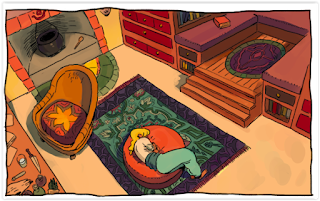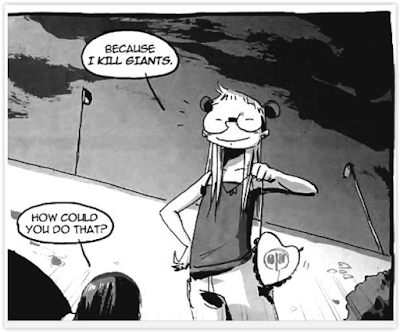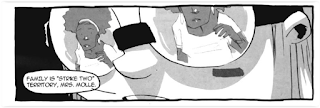So, you've been working on your magnum
opus for a while now. You've got some pages under your belt, and the
response is good. Then comes the first well-meaning fan asking “So,
will we ever see this in print?” Your head spins, thoughts of fame
and glory as a published author flash through your mind. You dedicate
yourself to the mission – printing your first comic.
Now what?
There's a lot of things to think about
when considering printing a comic. From the layouts to the finish, to
funding and distribution. I'm here to parse through some of the
concerns of printing, and give advice to newbies and comic veterans
alike!
For the first part of this we will talk about considerations for before you start writing and drawing
What? I have to start thinking about
printing that early?! Well, it doesn't hurt! If you already have your
art done, you should still review these suggestions, your work may
already be following industry guidelines.
Size and bleed
This is the size you will be working
at. Usually, it is informed by industry standards. American comics
usually print at 6.63"x10.24 and it is common to draw them on 11”x17”
boards. European Bande Dessinee are usually 8.4"x11.6" and made on
slightly larger paper. Manga is often 5.04"x7.17" but sometimes larger... so many sizes to choose from!
In general, working to one of these
common sizes makes printing cheaper, and gives you more options of
printers. However, many printers can also trim to other sizes at no
additional costs! I've seen great comics printed square, printed to
the size of a 45” record, printed in long scrolls, and even printed
on a large sheet and folded up into the finished size. Don't let
yourself get too tied down!
The other consideration of size, is
bleed. A lot of modern comics use bleed to make full use of the
paper. I've attached a handful of good guideline templates, you will
notice that many of them have two bleed marks - “safe area” and
“full bleed”. When the printer is working there's an acceptable
wiggle room in the registration, and each page may not be perfectly
centered. Thus, the safe area is the space which will never get cut
off. All your word bubbles and important action need to remain in
that space! The full bleed is the area which needs to be colored in,
so that while trimming there are no slivers of unprinted space.
 |
| That white strip at the top? In my first book I failed to account for bleed on the chapter covers. |
To be clear – the bleed is ADDED to
the page, the safe area is SMALLER than the page area. It's common to
buy bond pages with bleed/safe guidelines printed on them in no-photo
blue. If you are working entirely within the page, with gutters the
whole way around, you only need to be concerned with safe areas. Even
then, there should be plenty of margin to prevent anything that's
within those panels getting cut off.
Layout for printing
(image of page plan)
You've got your page size decided, time
to thumbnail! Whole articles would be written about thumb-nailing,
but here's what's important for print.
You are looking at pages as two page
spreads. Our eyes often take in the entire spread before focusing in
on the upper left to begin to read. If you want to build suspense, or
have an interesting reveal – make it on a page turn.
 |
| My thumbnails - two pages side by side, just like they will be in the book! |
Also, if you are making a two page
spread, with or without outer bleeds, you have to consider the inner
bleed – the part of the page which descends into the fold of the
paper. Just like outer bleeds, you will want to have the image reach
all the way to the possible edge of the paper, and have important
bits within the safe area. It's no good for people to be breaking the
spine just the read that word bubble! When designing a two-page
spread it's a good idea to have some repetitive boring business in
the middle, just to fill it up.
 |
| This image from an InDesign file actually cuts the bleeds out of the middle, lots of extra room for safety! |
Color processes
Doing black and white? Too bad! You
still need to consider file types and color profiles!
Printing uses CMYK color. This is an
additive color process, with the inks layering and mixing to achieve
the correct colors. A CMYK file splits into four images, with the
necessary amount of each color kept separate.
All screens use RBG color. It's
subtractive color (kind of, there's some interesting physics going on
which you can read more on
HERE). It splits down into three parts.
Almost all digital artist will work in
an RBG color file. It just makes sense. However, prior to printing it
needs to be converted to CMYK. This is best done when individual
pages are separate files, rather than converting an entire finished
PDF. Mostly, to ensure the color is still as intended! For scanned
files (colored analog, then digitized) there are rarely problems with
this conversion. In fact, many scanners can scan in CMYK if the image
is going to be sent directly to printing and not used online first.
BUT, for digital artist, that
conversion can cause strange things to happen to the colors. There
are certain parts of the spectrum that are unavailable in RBG, and
others that are difficult to reproduce in CMYK. Obviously, reviewing
it on a screen is imperfect, but it usually reveals color problems,
and allows them to be fixed!
Even if you are working in black and
white, you will still need files that are the correct output, and
CMYK is fine.
Rich Blacks
It is not uncommon for people to
convert the blacks of a comic to Rich Blacks for printing. This is
particularly important for very dark comics! If a black is coded as
just being the “K” part of CMYK, then it's actually only getting
one layer of ink. If there's anything being printed underneath it,
even just “artifacts” that are covered by it in the finished
image, they may show through. Rich Black is the layering of all four
colors of ink to make the darkest black (just like your art teacher
made you do in 1020...)This is recommended for all lettering and
bubbles, to make them very legible over the art.
(I'm not going to go over the technical
details of doing this, but
here's
some tutorials!)
In Conclusion - taking a moment to consider printing guidelines before you even start writing, drawing, and producing your comic will save you a lot of trouble in the long run!
In the next segment I'll talk about the language of printers, pricing your book, and funding. Stay tuned!
Note from the MC: this article is written courtesy of Pink Pitcher, Author of Root And Branch, which is currently on its third published volume. A tip of the hat to you Pink!
 The color scheme is well-chosen and vibrant, capturing the feel of times and places in an almost impressionistic fashion. Stylistically reminiscent of watercolor and animation both, it's a well-crafted treat for the eye. The world building is gorgeously done: you feel you could walk into the crowd scenes.
The color scheme is well-chosen and vibrant, capturing the feel of times and places in an almost impressionistic fashion. Stylistically reminiscent of watercolor and animation both, it's a well-crafted treat for the eye. The world building is gorgeously done: you feel you could walk into the crowd scenes.  And then Witchy will capture your heart. This is a story of stubborn hope in the face of overwhelming odds. It's a story of devotion to your loved ones and integrity in the face of all the world's demands to conform. Witchy manages to explore themes of personal strength, identity, autonomy and personal decision perfectly: without preaching or creating situations that feel forced, it creates storylines that lets us see the many facets of characters' identities and truly explore the idea that diversity is a culture's strength. The weakness in one member of a society should complement the strength in another. When we laud only some strengths and only some ways of being, we soon become dangerously out of balance. The issue of how to be authentic in an unbalanced society is explored in beautiful detail here.
And then Witchy will capture your heart. This is a story of stubborn hope in the face of overwhelming odds. It's a story of devotion to your loved ones and integrity in the face of all the world's demands to conform. Witchy manages to explore themes of personal strength, identity, autonomy and personal decision perfectly: without preaching or creating situations that feel forced, it creates storylines that lets us see the many facets of characters' identities and truly explore the idea that diversity is a culture's strength. The weakness in one member of a society should complement the strength in another. When we laud only some strengths and only some ways of being, we soon become dangerously out of balance. The issue of how to be authentic in an unbalanced society is explored in beautiful detail here.





























